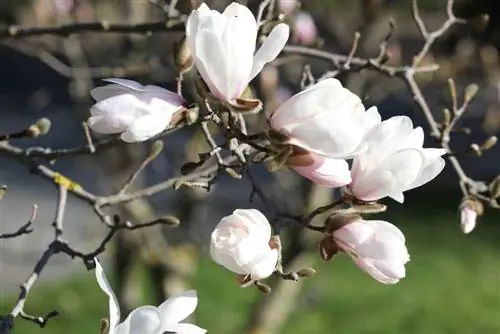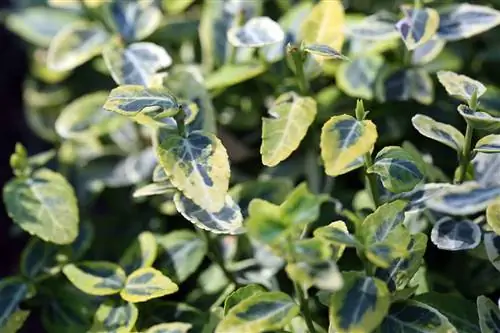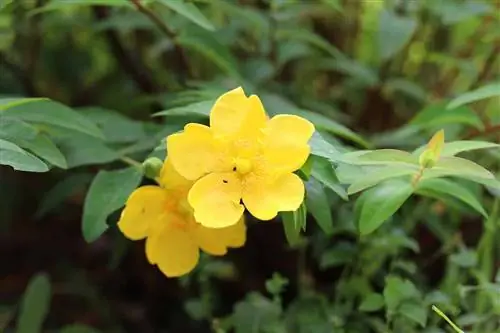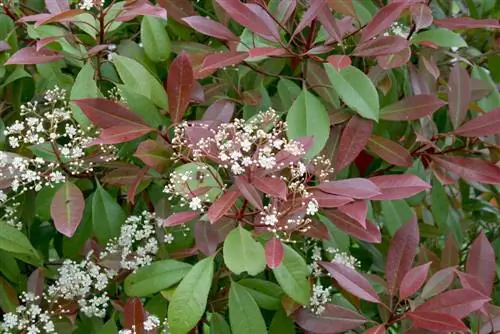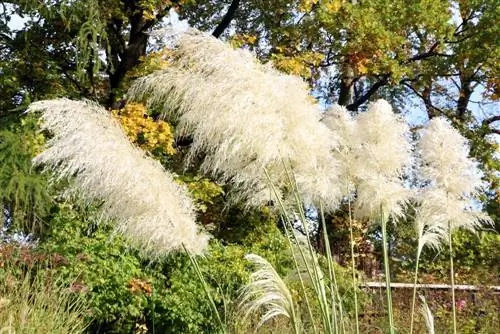- Author admin [email protected].
- Public 2023-12-17 03:39.
- Last modified 2025-01-24 12:45.
The evergreen magnolia is still one of the rarities in this country. You rarely see the tree with the large white flowers. This magnolia is something very special because it retains its leaves even in winter. But some gardeners are worried about the cold season, because the Magnolia grandiflora is known to be sensitive to cool temperatures. For this reason, it is not recommended to plant a large-flowered magnolia outdoors in particularly cold areas. There are now also a number of varieties that are no longer so bothered by cold temperatures.
Short profile
- botanical name: Magnolia grandiflora
- other names: large-flowered magnolia
- belongs to the magnolia genus
- Growth height: up to around 25 meters
- grows very slowly
- Flowers: white, tulip-shaped, up to 20 cm in diameter
- Flowering time: from May, occasional flowers until July
- Foliage: dark green, leathery, shiny
- evergreen
Occurrences
The evergreen magnolia is a very special plant species from the magnolia genus (Magnolia), because it not only keeps its leaves all year round, it also produces particularly large flowers. The evergreen tree, which can reach a height of over 25 m when old, originally comes from southeastern North America. There the tree is found primarily in coastal lowlands along the Gulf of Mexico in warm temperate to subtropical climates with relatively high amounts of precipitation. The Magnolia grandiflora is considered a character plant of the southern states and is also affectionately called “Soutern Magnolia”.
Location
The evergreen magnolia prefers a sunny to partially shaded location, which offers it protection, especially in the winter months. In wine-growing regions it can be planted practically anywhere in the garden as long as the soil and light conditions are right. In slightly cooler climates it feels more comfortable in a sheltered place.
- Lighting conditions: sunny to light partial shade
- Soil: humus with good water storage capacity, rich in nutrients
- pH value: preferably slightly acidic
- protected from strong winds
- best suited as a solitary plant because of its height.
Tip:
Flowering dogwoods (Cornus florida), pine trees (Euonymus americanus) and the Virginian wax tree (Myrica cerifera) are particularly suitable for the understory of the large-flowered magnolia.
Frosthardiness
To generally claim that the evergreen magnolia is very sensitive to frost is simply wrong. But the fact is that there are big differences from variety to variety. Young magnolias in particular react very sensitively to cold and icy winds. With increasing age, when the tree or shrub is well established, the winter hardiness becomes a little better, but is still far from being comparable to the frost resistance of native trees. The following varieties should therefore only be planted outdoors in very warm areas, such as wine-growing regions. Alternatively, planting in a container is of course possible.
- 'Little Gem': early flowering, compact growth habit, sensitive to frost
- ‚Galissonière: comes from France and is considered the most common variety, not particularly frost hardy, but very heat tolerant
- 'Goliath': loose, upright growth up to 8 m, forms a closed, rounded crown, flowers at a young age
Fortunately, there are also breeds that generally tolerate frost better than others. These varieties usually come from North America. These include:
- 'Bracken's Brown Beauty': one of the most frost-hardy species ever (down to -25 degrees), slightly smaller leaves and flowers, the crown is slightly pyramidal in shape
- 'Edith Bogue': small growing species with light green underside of leaves, very hardy
- 'Exmouth': very old variety (1737), slender crown, light foliage, tolerates permanent frosts
- 'Victoria': compact, dense, slightly smaller growth, frost hardy down to -25 degrees, comes from Canada
Tip:
Even if some of the frost-sensitive magnolias survive in harsh locations, after a few years the trees tend to develop a poorly grown crown and only produce a few flowers.
Plants

The planting time for the large-flowered magnolia is ideally in spring. Since the tree can grow very large, it should be planted at an appropriate distance from buildings and property lines. Larger plants (or trees) can also be used in autumn in mild regions. In this case, a thick layer of mulch should protect the plant from the root ball freezing.
- Time: Spring
- Planting hole: at least twice the ball size
- Enrich soil with humus
- If necessary, incorporate grit or coarse sand (if there is a risk of waterlogging)
Pouring
Since the evergreen magnolia grows in its homeland, the southern states of the USA, preferentially in river basins or near swamps, it also needs soil in the garden that can store moisture well. The tree cannot tolerate permanent waterlogging, but it does tolerate short-term flooding. Ideally, the soil should be consistently moist. Therefore, regular watering is necessary in periods of little rain, especially in midsummer. Like other evergreen trees, Grandiflora evaporates water through its leaves in winter. That's why it needs to be supplied with sufficient moisture even in the cold season. The Magnolia grandiflora responds to drought by dropping its leaves.
Fertilize
This type of magnolia prefers heavy, nutrient-rich soil and must therefore be supplied with fertilizer when necessary. A nutrient deficiency is clearly evident in the fact that the large-flowered magnolia suddenly loses more leaves, even though it is watered adequately. Potted plants are supplied with a high-quality liquid fertilizer for potted plants via irrigation water every two weeks during the growing season. For planted specimens, it is recommended to fertilize with compost three times, in March, May and June. Alternatively, a good organic-mineral combination fertilizer can be used for flowering bushes.
Substrate for potted plants
One thing is particularly important for planting Magnolia grandiflora in pots: very high-quality soil. However, it is advisable not to cultivate the evergreen magnolia in a planter long-term, because after 10 to 15 years at the latest, the tree (especially its roots) simply becomes too big for the pot. The trees are only repotted every three to four years in spring when the roots are well rooted.
- coarse-grained components (such as expanded clay, lava granules, grit)
- ensure structural stability and drain excess water well
- moderate clay content
- high humus content
Propagate
Magnolias can be propagated by seeds, cuttings, cuttings or even mosses. The easiest way of propagation for inexperienced hobby gardeners is to grow from seeds or cuttings.
Cuttings
The time for cutting cuttings differs for evergreen magnolias from deciduous magnolia species. The cuttings are cut from a he althy, strong shoot in late summer or early autumn.
- cut half-woody shoot tip
- Length: about 10 to 15 cm
- remove lower pair of leaves
- Slightly scrape the bark in the lower area
- stick in moist substrate
- Substrate: soil-sand mixture, potting soil or cactus soil
- set up frost-free and brightly
- Keep soil slightly moist
- plant outdoors (or in pots) next spring
Seeds
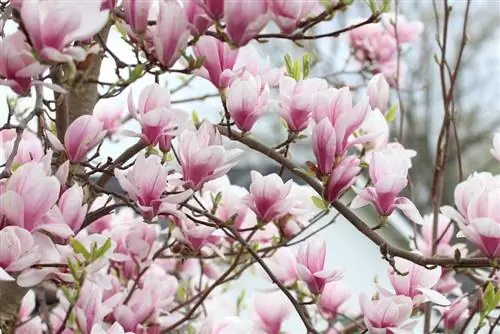
After flowering, the large-flowered magnolia forms inconspicuous, hairy seed follicles in which the red-brown seeds ripen. These can be taken for propagation. However, growing magnolia seeds is a bit complicated. First, the seeds must be freed from the orange seed coat, as this has an inhibiting effect on germination. To do this, the seeds can be rubbed several times with water and sharp sand. A cold period is also necessary before germination.
- place cleaned seeds in a bag with moist sand
- store in the vegetable compartment of the refrigerator for several weeks
- from around the fourth week the seeds slowly begin to germinate
- Carefully remove the seedlings and place them in the substrate
- Leave the remaining seeds in the bag and put them back in the fridge
- Substrate: cactus soil, potting soil or peat moss
- Keep soil slightly moist
- Location: partial shade (not dark)
- no direct sun
- Temperature: 15-20 degrees
- Growing pot: deep rather than wide
- the seedling initially forms a taproot
- later a heart-shaped root system
Tip:
The seedlings of the large-flowered magnolia have the ability to grow in the shade even under an almost closed canopy. That's why they can easily be sown in the shade of the mother plant.
Cutting
If you bring an evergreen magnolia into your garden, you should plan plenty of space for the noble tree. Although the tree grows very slowly, it can reach a height of over twenty meters when it is old. The crown also becomes quite expansive, with the branches of the tree usually only branching out a little. A Magnolia grandiflora does not necessarily need to be cut. It is sufficient to light them regularly and remove dead shoots. All large-flowered magnolias form their flower heads the previous year and sprout from the old wood after the winter. If you don't want to miss out on a flower next spring, you should take this into account when cutting.
- Time: Late winter
- alternatively (without flower loss): after flowering
- choose a rain-free, slightly cloudy day for cutting
- take out all dead and diseased branches
- cut off branches that cross or grow inwards
- If the crown is to grow denser, the branches are shortened to about 2/3
Wintering
Large-flowered magnolias cultivated in wine-growing regions do not require any special protection in winter. In all other regions, magnolia trees should be protected from the icy weather as best as possible. If you plant your evergreen magnolia outdoors, you should choose one of the more frost-hardy varieties to prevent failure due to frostbite. If such a specimen were to freeze back, it is able to recover and sprout again from strong trunks and branches.
Outdoor plants
As a rule, it is sufficient to cover the sensitive root area of the Magnolia grandiflora with a thick layer of bark mulch, brushwood or leaves. This is necessary because the magnolia only develops very shallow roots, which freeze completely in cold temperatures. Young trees can also be covered with a fleece or a jute bag if they are exposed to strong sunlight at temperatures below zero. In this case, the plant evaporates water through the leaves but cannot absorb new water from the soil. This is how dehydration occurs. To protect it, simply place the bag over the crown of the plant and carefully tie it together at the bottom. However, it must not remain on the plant longer than absolutely necessary.
Tip:
The crown must never be covered with a film that is impermeable to air. This means the air cannot circulate and moisture builds up. Mold formation on the plant can usually be seen after a short time.
High trunks in the open field
All plants that are cultivated as standard trees require special winter protection outdoors.
- Wrap trunk with fleece
- Protect the crown with a jute bag in strong sunlight
- Hill the root area in layers
- bottom layer: bark mulch
- middle layer: foliage
- bottom layer: straw or brushwood
potted plants
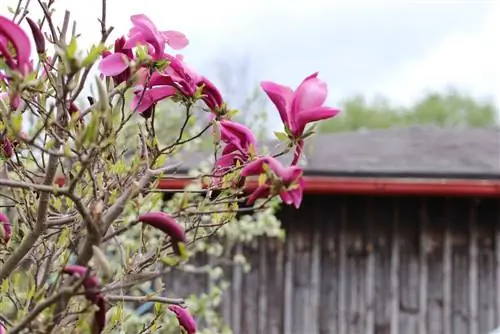
Evergreen magnolias in pots should be moved to a bright and cool, but frost-free area during the cold season. Since the plants retain their foliage, it shouldn't be too dark there. In principle: the warmer the location, the brighter it is. During this time, you should not forget to water the Magnolia grandiflora regularly (although more sparingly than in summer). There is no fertilization at all between August and March. Suitable for wintering are:
- frost-free greenhouses
- cool winter gardens
- a garage with a window
- a cool, bright basement room
Diseases and pests
Basically, the evergreen magnolia is rarely affected by pests or diseases. Nevertheless, in individual cases an infestation with pests or pathogens can occur. The most common problems are known for potted plants that are overwintered too warm, too dark or too dry:
- Mildew
- Whitefly
- Scale insects
Tip:
As a rule, diseased magnolias recover quite quickly and only in the rarest of cases do they suffer serious damage as a result of the infestation.
Conclusion
Evergreen magnolias are a very special addition to the garden. However, if you don't live in areas with mild winters (wine-growing regions), you definitely have to pay attention to the right variety when planting outdoors, because not all trees are frost-resistant. Sensitive varieties should therefore be planted in a pot and overwintered in a cold house. If you want to be on the safe side when planting outdoors, it's best to buy the most cold-resistant varieties: Magnolia grandiflora 'Bracken's Brown Beauty' or 'Victoria'.

